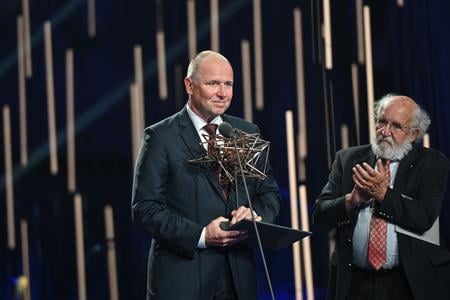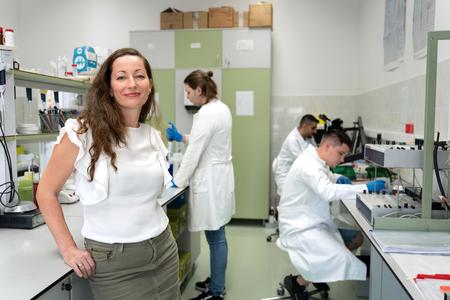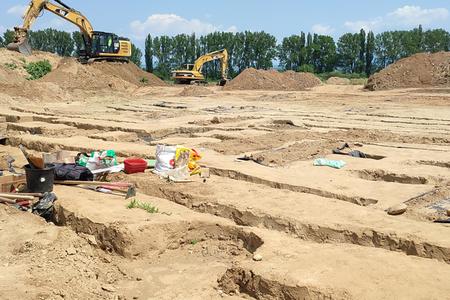An ‘impossible world’ may sound like something out of a science fiction story, but it is in fact a real concept in philosophy used to model phenomena that cannot be imagined using the possible. Now, thanks to a Slovak researcher, the prestigious Internet Encyclopaedia of Philosophy has an entry on the topic.
This article is supported by the ESET Foundation, whose annual ESET Science Award recognises exceptional scientists.
Although no longer dominating global headlines, Covid-19 is still with us and research into the disease continues. Slovak scientists have now found a link between a severe form of the disease and the activity of an enzyme in blood.
These are just two of many stories of science in Slovakia and Slovak scientists around the world. The Slovak Spectator has spoken to scientists about their research and its potential contribution to society, and the following summary gives an overview of their progress.
This overview of successes in Slovak science will be compiled regularly. To stay up to date with what scientists in Slovakia and Slovak scientists around the world are doing, subscribe to the Slovak Science newsletter, sent to readers free of charge four times a year.
ESET Science Award laureates announced
In October, the ESET Foundation announced the laureates for the fifth annual ESET Science Award.
This year's laureates were selected by an international jury chaired by 2019 Nobel Prize laureate and astrophysicist Michel Mayor, who in 1995, along with Didier Queloz, discovered 51 Pegasi b, the first extrasolar planet orbiting a sun-like star.
He also took part in a public debate with astrophysicist and co-founder of the Starmus festival Garik Israelian on our search for life in outer space. The festival will be held in Bratislava next year.
In the Outstanding Scientist in Slovakia category, the committee chose Igor Lacík of the Polymer Institute of the Slovak Academy of Sciences (SAV). He and his team are looking into the use of polymeric materials in the treatment of diabetes.

Mechanochemist Matej Baláž from the Geotechnics Institute of SAV in Košice was chosen as the Outstanding Scientist in Slovakia Under the Age of 35 laureate. As the name of the field suggests, he uses mechanical energy to perform chemical reactions. For example, Baláž wrote a monograph on mechanochemical processing of eggshells and their use in wastewater treatment.
This year's Outstanding Academic in Slovakia award laureate is Daniela Ostatníková, head of the Institute of Physiology at Comenius University in Bratislava. Her research focuses on the causes of autism.
The awards are intended to recognise exceptional individuals in Slovak science, taking into account not only their work, but also their contribution to other areas of life.
Continuing research into Covid-19
Although for the public Covid-19 is no longer dominating daily life, for some scientists that is far from the case. Research into the coronavirus and the disease it causes continues, and Slovak scientists are helping too.
Recently, a team from the Faculty of Pharmacy at Comenius University in Bratislava found a link between the severe form of Covid-19 and the activity of an enzyme, butyrylcholinesterase, in blood.
Their study showed that a decrease in the activity of the enzyme was associated with a negative Covid-19 prognosis and vice-versa. Lead scientist Anna Paul Hrabovská talked to the Slovak Spectator about how the research began and what it has found. The response to the study so far has been positive.
In addition, the enzyme has been connected to various pathologies such as cardiovascular, oncological and metabolic diseases. Paul Hrabovská believes it may be a general biomarker of mortality.

Once popular, always popular
A popular quip about eastern Slovakia is that "there's nothing out there".
If that were the case, Swedish carmaker Volvo would not have chosen the Valaliky industrial park near Košice as the site of its new electric vehicle production plant. German engineering and technology company Bosch has decided to expand its production in the region too.
Archaeological research is now showing that Valaliky and the surrounding area once held appeal for people in the distant past.
At the beginning of summer, scientists from the Institute of Archaeology of the Slovak Academy of Sciences completed their first six months of investigations at the site. Led by Marek Vojteček and Michal Cheben, the team uncovered the remains of settlements, burial mounds and a burial site, and many other unique finds.

Space cluster in eastern Slovakia
Space research is not something many would associate with Slovakia. However, the country understands that the ‘space economy’ is growing rapidly. With this in mind, a memorandum on the establishment of the East Slovak Space Cluster was signed in September.
Participants include the Technical University in Košice, Deutsche Telekom IT Solutions Slovakia, the Institute of Experimental Physics of the Slovak Academy of Sciences, the Pavol Jozef Šafárik University in Košice and the Slovak Investment and Trade Development Agency (SARIO).
The development of the Slovak space sector has the potential to attract and retain talent in the region.
"The aim of the cluster is to connect stakeholders carrying out research and development, commercial and promotional activities in the field of space technology and to create a supportive ecosystem for the formation of new innovative start-ups bringing new products and services using space technologies," TUKE states on its website.
Overview of other research and development activities in universities:
Advanced electronics with supercaps; University of Žilina; lead scientist Michal Fridvalský. The team is researching an advanced autonomous power system for space robotic arms and have prepared the groundwork for a physical prototype of the device.
Traction drive for dual locomotive DualShunter 2000; University of Žilina; lead scientist Matěj Pácha. The Department of Power Systems and Electric Drives has developed an algorithm for controlling a traction drive with asynchronous motors in locomotives and trial operation has been initiated.
Novel semiconductors and catalysts for green hydrogen production; University of Žilina; lead scientist Peter Cendula. Photo-electrochemical cells allow conversion of solar energy into fuel. Their conversion efficiency is directly dependent on their photovoltage, the monitoring of which is, however, difficult using standard methods. The paper shows such monitoring can be done wirelessly.
Emotional experience of people with schizophrenia and people at risk of psychosis; Comenius University; lead scientist Marcel Riehle. Meta-analysis indicates a specific pattern of disturbed emotional experience in people with schizophrenia, manifesting even before the onset of the disorder. People with schizophrenia and those with a high risk of developing psychosis experienced pleasant stimuli as less positive and more negative. Read more.
Reading comprehension and vocabulary assessment in children; Comenius University and University of Prešov; lead scientist Svetlana Kapalková. The study examines the concept of reading comprehension from a longitudinal point of view and shows that the fundamental factor predicting reading comprehension is a child's verbal speech level.
Psychological and biological correlates of behaviour in children with autism; Comenius University; lead scientist Katarína Babinská. Compared to the general population, individuals with autism experience deviations in the functioning of their immune system. The project reveals new, until now unknown connections between the biological and psychological aspects of autism and at the same time raises new questions.
Professor Rory Fitzgerald, the current Director of the European Social Survey European Research Infrastructure, was awarded the International Prize of the Slovak Academy of Sciences in the field of social and cultural sciences. He made a significant contribution to ensuring the continuity of the ESS project in Slovakia. In addition, due to his support, Slovakia became a full member of the infrastructure in 2018. Read more.
Entry in the prestigious Internet Encyclopaedia of Philosophy; Slovak Academy of Sciences; lead author Martin Vacek. The entry provides motivation for postulating impossible worlds as a tool for analysing impossible phenomena and deals with their logic, application and problems. Read more.
Other Slovak science stories on Spectator.sk:
MACHINE LEARNING: People believed that both language and creating meaningful text were the domain of humans alone. But when it comes to difficult things like folding proteins, or playing complicated games like chess, it is not surprising that AI can do those too, says Michal Valko, Slovak machine learning scientist at DeepMind in Paris, a Google company. "However, with chatbots, it turns out that it is not as difficult as we thought," he says in an interview.
ARCHAEOLOGY: A gun found off the coast of Sweden that is possibly the oldest ship cannon on record in Europe was cast using a copper alloy. The copper was mined near Banská Bystrica, Slovakia.
PREHISTORY: Around 11 million years ago, the territory of what is today Slovakia looked entirely different. The plains of western and south-eastern Slovakia were covered by the Pannonian Sea. In the north, the Turiec Basin was filled with an isolated and shallow lake. Now scientists have determined when the lake existed, and when it disappeared.
WATER: Throughout its history, Slovakia has had to cope with many environmental burdens, most of which originated under the communist regime. Scientists are devising methods to tackle these individual burdens, for example the use of biomining to extract metals that entered rivers due outflows of mining waters.
PALEONTOLOGY: An international team of scientists, including Slovak palaeontologist Andrej Čerňanský, has unearthed fossils of an unknown lizard that lived at the end of the dinosaur era. The team was working in western India.
FOREIGN SCIENTISTS IN SLOVAKIA: Austrian scholar of comparative literature Johannes Kaminski is based at the Institute of World Literature at the Slovak Academy of Sciences. He studies how climate change is depicted in national literatures.
This article is supported by the ESET Foundation, whose annual ESET Science Award recognises exceptional scientists.


 This year's ESET Science Award laureates, from left: mechanochemist Matej Baláž, autism researcher Daniela Ostatníková, and polymer chemist Igor Lacík. (source: ESET Science Award/Linda Kisková Bohušová)
This year's ESET Science Award laureates, from left: mechanochemist Matej Baláž, autism researcher Daniela Ostatníková, and polymer chemist Igor Lacík. (source: ESET Science Award/Linda Kisková Bohušová)